💸 See if your business qualifies for a tax credit worth up to $26k per employee. 📞 Call Now: 855-979-9597
Best Payment Apps for Small Businesses
We are committed to sharing unbiased reviews. Some of the links on our site are from our partners who compensate us. Read our editorial guidelines and advertising disclosure.
Cash apps are becoming more and more popular among consumers. What started as a way to pay a friend back for that pizza they bought you has blossomed into a huge industry of customers who want to pay for your goods and services using their favorite payment app.
As a business owner, you can capture these payment app sales in one of two ways:
- By getting a credit card processing system or POS (point of sale) system that integrates with the most popular payment apps and digital wallets
- By installing a few popular payment apps on your phone
This article focuses on the second solution, recommending need-to-have apps for peer-to-peer (P2P) payment transactions. The one limitation of this second approach is that it’s most useful for small-business owners who are making payment transactions on their phone. It’s not a great solution for a brick-and-mortar business that needs a more permanent processing solution.
- : Best overall
- : Best for Apple users
- : Most widely used
- : Best Bluetooth integration
- : Highest transfer limit
Google Pay: Best overall
Google Pay should be on your phone if you use payment apps to make sales. You can set up a Google Pay business account and integrate that account with a POS system. Google Pay currently integrates with many popular payment platforms:
- Clover
- Square
- 3dcart
- Braintree
- First Data
- Stripe
- Worldpay
- Shopify
In addition to being designed with small business in mind, Google Pay also has the lowest credit card processing rate of any of the most popular payment apps at 2.9%.
So, if you have a Google account and a phone, it’s easy and smart to have Google Pay as a way to send and receive cash.
Apple Pay: Best for Apple users
If you have an iPhone, you probably already have Apple Pay installed on your phone. The same can be said about any other iPhone user. Because of this, it’s easy to send and receive money from other Apple users.
You can even send and request money via text message instead of having to manually type in an email address on your phone, like in other peer-to-peer payment apps.
You can also use Apple Pay to make purchases at stores with terminals that accept Apple Pay. By that same logic, you yourself can accept Apple Pay if you get the right payment processing terminal. Many modern processing providers, like Square, offer terminals that accept Apple Pay.
Venmo: Most widely used
If you’ve heard the phrase, “you can just Venmo me for the pizza,” then you know why Venmo is on this list. Not only is Venmo a very widely used P2P payment app, it also has some of the quickest withdrawal times of any payment app on the market.
Venmo is also great if Facebook is one of your primary markets for selling your wares. You can link your Venmo account to your Facebook friends list right from the get-go, making all of your Facebook friends with Venmo available for money transfers—it’s that easy.
Venmo doesn’t have many other bells and whistles to speak of, but its popularity makes it a must-have app for any business owner looking to take mobile payments.
Cash App: Best Bluetooth integration
You don’t have to download Cash App if you have all the above-listed apps, but you may find it useful if you’ve noticed clients asking to pay you on the platform.
One of the cool things about Cash App is its ability to make and receive payments over bluetooth. You can open the app and send money to anybody with the app enabled in the area. No numbers, no email addresses.
Also, if you’re feeling daring, you can use Cash App’s Bitcoin investment feature that lets you buyBitcoin holdings straight from the app. While it’s probably not the best way to get yourself into the cryptocurrency game, it’s sure one of the easiest.
PayPal: Highest transfer limit
Compared to other peer-to-peer payment apps, PayPal has the highest transaction fees. This makes it hard for us to recommend it as your main payment app, but you shouldn’t discount it completely. PayPal can be really useful if you need to make big transactions over a payment app.
With PayPal, you can send up to $60,000 in transfers. That said, you can only send $10,000 per transfer. PayPal also has a lot of ways it lets people pay you. They can pay you with a card, with their PayPal account, or directly from their bank account.
By signing up I agree to the Terms of Use and Privacy Policy.
Honorable mentions
The takeaway
Payment apps are an incredibly easy way to send and receive cash between friends, associates, and customers. While it may not be the best long-term payment-processing solution, it’s great to have the most popular payment apps downloaded and ready for those on-the-spot transactions.
To really up your mobile-processing game, check out our picks for the top mobile card readers.
Payment app FAQ
Payment apps are useful for transactions on the go and from home. That said, we recommend using a more sustainable processing method if you are receiving more than $10,000 a month, as you may be able to save money on fees.
If you are receiving a good chunk of change on P2P apps, you may want to look into mobile processing solutions. A number of credit card processors, like Square and Payment Depot, offer mobile payment apps with lower transaction rates.
It depends. For one-off money transfers, a payment app is great. But if you’re selling food at a farmers market and need to keep track of sales and inventory, using a dedicated mobile reader for a POS system like Square will make it easier to process and track many transactions.
Also, processors like Square and Payment Depot have cheaper transaction rates. If you receive $10,000 a month in credit card transactions with an average ticket price of $500 per transaction, you’ll pay $261 in total fees with Payment Depot versus $300 in fees with Apple Pay.
Our methodology
We’ve vetted these companies with small-business owners in mind, looking for traits and features that best serve small-business needs, like these:
- Ease of integration. How easy is it to start taking credit card payments? How long is the sign-up process?
- Fees and costs. What’s the cost per swipe? Are there monthly fees?
- Customer service. Is it easy for a customer to contact customer service? Are the service representatives effectively resolving issues as they crop up?
Disclaimer
At Business.org, our research is meant to offer general product and service recommendations. We don't guarantee that our suggestions will work best for each individual or business, so consider your unique needs when choosing products and services.













